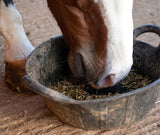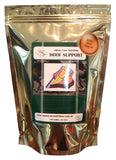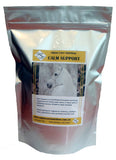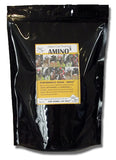Creating a diet
 Perhaps you have a new horse that needs to put on a bit of weight, or maybe you are upping exercise with the better weather and need to increase the amount you feed. Where do you start? How do you put together a diet that meets all the nutritional needs of your animal? In this article we will take you through the main areas to consider, and point you in the direction of some useful resources along the way.
Perhaps you have a new horse that needs to put on a bit of weight, or maybe you are upping exercise with the better weather and need to increase the amount you feed. Where do you start? How do you put together a diet that meets all the nutritional needs of your animal? In this article we will take you through the main areas to consider, and point you in the direction of some useful resources along the way.
Roughage, roughage and more roughage! The basis of your horse’s diet needs to be roughage (pasture, hay, chaff etc). Why? It is what the horse has evolved to eat. The design of the digestive tract reflects this: from teeth that grind in a circular motion to a large hind gut that ferments fibrous plant material. The horse needs a minimum of 1% of Body Weight a day in roughage just to maintain digestive tract function. Requirements will be higher with increases in activity level. For instance a 400kg horse in the paddock should ideally be getting 7kg of roughage a day, but this should increase to 10kg a day when that horse is in moderate work. A diet high in roughage has numerous health benefits: chewing plant fibre produces saliva which contains bicarbonate which helps to buffer the acid in the stomach. Once swallowed, this fibrous mat of chewed plant matter and saliva help protect the non-glandular upper stomach from sloshes of acid produced by the glandular, lower part of the stomach. Horses worked on an almost empty stomach are at much higher risk of gastric ulcers resulting from acid damage to the upper stomach lining. A steady flow of fibrous feed through the digestive system helps prevent impaction, a cause of colic, at ‘bottle neck’ sites along the digestive tract. Sufficient fibrous material also helps weigh down the colon, which to a large extent is free to move around within the abdomen: without weight to hold it in place it can displace or twist, also common causes of colic.
With roughage as the basis of a diet it can be very beneficial to have an analysis carried out of your hay and/or pasture to ascertain its nutrient levels. This can be carried out in Australia by the labs at Feed Central www.feedcentral.com.au. A large range of species and environmental factors go into determining the nutrient values of roughage, but in very broad terms meadow hay has crude protein levels of around 8-13% and provides approximately 9-11 Megajoules per 1kg Dry Matter. Grass provides roughly 16-18% protein and 12 Megajoules per 1kg Dry Matter. Horses grazing grass ingest approximately 10kg of grass in an hour, which equates to roughly 2kg of Dry Matter (DM). Grass is approximately 20% dry matter and 80% water. Hay is roughly the reverse, about 80% dry matter, 20% moisture.
Talk of Megajoules brings us to the first element we need to get right: making sure the total daily food we are feeding provides enough energy for our horse’s bodily functions and energy expenditure through exercise, pregnancy or lactation. A 400kg horse in the paddock needs around 55 MJs a day to maintain body function and condition, but throw in moderate exercise and requirements go up to 78 MJs a day. A great free online resource for this information can be found at www.feedingthehorse.com.au It is a good idea to make regular checks of your horse’s weight with a weight tape and learn to visually assess his Body Condition Score: this rates condition on a scale of 1 (emaciated) to 9 (obese) based on fleshy covering at various points on the body. Keeping a regular record will ensure his diet is on track and he is not losing or gaining weight.
If your horse does need to gain weight it takes a gain of 18-20kg in body weight to move a horse’s Body Condition Score up one place on the scale. A healthy weight gain is around 225g a day so it is going to take at least 80 days of consistent weight gain to achieve this. Alternatively if your horse needs to lose weight it is important to aim for a slow and steady weight loss of 0.5% body weight per week. For example in overweight pony that weighs 300kg this would be a loss of 1.5kg per week. Never try to reduce weight by more than 1% per week. Usually feeding between 70-90% of current energy requirements is enough to generate weight loss. When developing a weight reducing ration remember that you must feed at least 1% of body weight in roughage (hay, chaff etc) per day to maintain digestive health.
The next big element to get right is protein. A 400kg horse at rest needs around 500g of crude protein a day, and again this will increase with exercise or breeding demands. And protein is needed for more than just muscle development - myriad structures and functions within the body also need the amino acids from protein: muscle, hoof, hair, bone, immune function, energy generation to name a few. As well as meeting overall protein needs, the horse also needs specific “essential” amino acids, such as Lysine which have to be provided through the diet. Some amino acids (non essential) are synthesised within the horse’s system, but the 10 essential amino acids have to come from food.
With energy and protein taken care of, the final element of a diet is ensuring vitamin and mineral needs are met. This is where a grass/hay analysis really pays dividends, providing key information on which to build a supplementation regime. Many common health complaints can be traced back to a dietary deficiency: abnormal bone growth, weak bone, muscle weakness, irritability, irregular heartbeat, joint disease, poor hooves, dull coat, tendon and ligament problems, poor wound healing, decreased fertility, respiratory distress. When a mineral deficiency can have such an impact on the health of your horse it only makes sense to ensure that mineral needs are being met. However, it is not quite so simple as certain minerals actually compete for absorption within the body: high phosphorous intake suppresses calcium absorption; high iron suppresses zinc absorption; high zinc affects copper levels. In effect an excess in one mineral can lead to a deficiency in another. To overcome this certain minerals need to be provided within balanced ratios. Supplementing across the board can exacerbate deficiencies by providing more of a mineral that is already in excess, further reducing the absorption of minerals it may compete with. A truly balanced diet will have mineral deficiencies and excesses taken into account and supplementation where required will be within balanced ratios that address specific deficits.
If you want the absolute best for your horse, make sure you are providing an adequate and well balanced diet: he is totally reliant on you to provide him with the nutrients he needs for good health and to perform at his best. Nutrition can be used to help exercise adaptation, aid recovery after a hard work out, improve immune function, or handle stress at a competition. Consult a nutritionist, look up resources or use the diet creation tools that are now available so that you are not making feeding decision in the dark. Give yourself the gift of knowledge and your horse the gift of good health.
|
RELATED PRODUCTS |
|||
 |
 |
 |
 |
| Hoof Support | Calm Support | Omega-3 | Amino-3 |